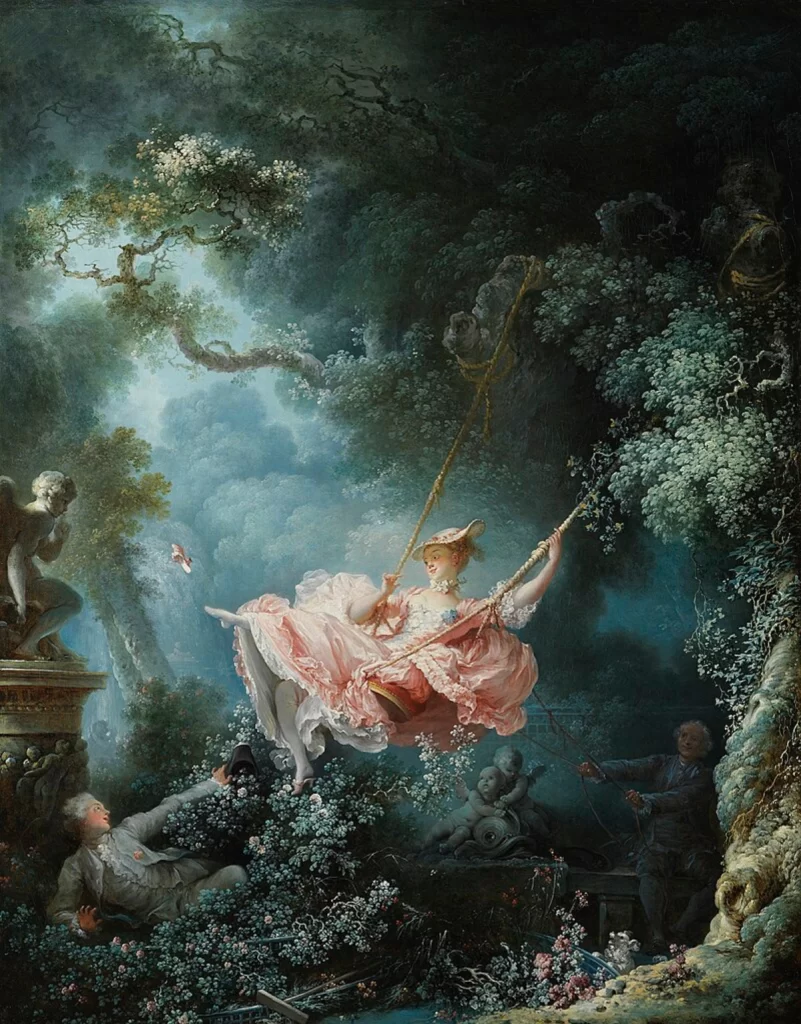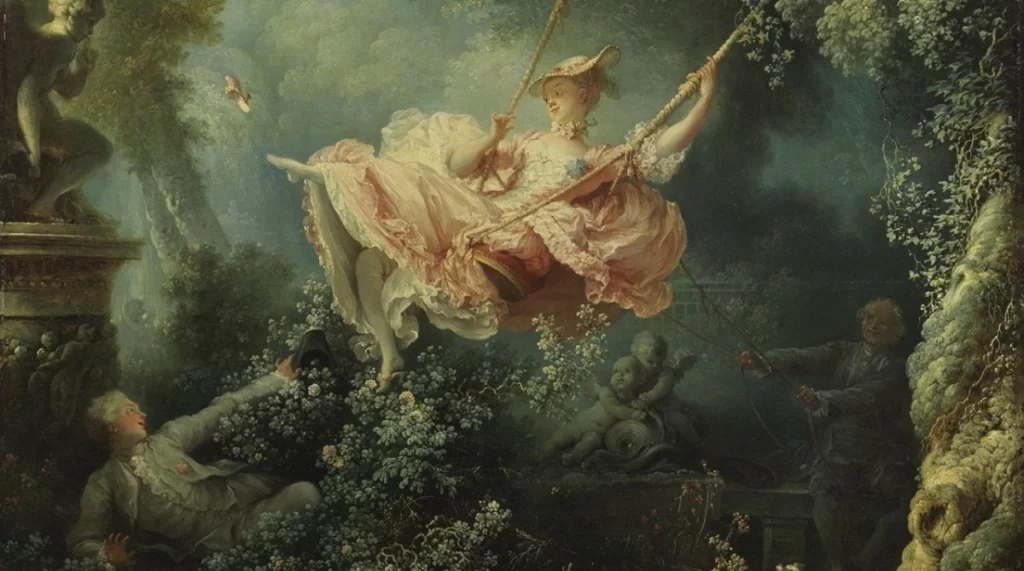A Masterpiece of Playful Provocation: Secrets Behind the Brushstrokes
Renowned artist Jean-Honoré Fragonard painted “The Swing” in 1767, during the Rococo era. The image shows a young woman on a swing being pushed by an older man as another young man watches her from behind some bushes. The scene is in a gorgeous garden overflowing with flowers and vegetation.
In addition to its elaborate features and brilliant colours, the picture is renowned for its whimsical and romantic quality. Fragonard’s use of light and shadow gives the painting depth, heightening the whimsical and carefree mood. The woman’s exquisitely designed clothing highlights the Rococo aesthetics’ emphasis on decoration and grace.
From the Wallace Collection to Art History: Why The Swing Still Captivates
Upon The Swing painting analysis, you can easily figure that it is a high symbol of the Rococo era. It is known for its fanciful, whimsical, and joyful Rococo aesthetic. This style responded to the luxury and formality of the Baroque era, emphasizing intimacy, fun, and visual beauty in its place. The painting, made during Louis XV’s reign, captures the aristocratic way of life and societal norms of 18th-century France. It depicts the excess and frivolity of the French upper class. It was later criticized and said to have contributed to the French Revolution.
Fragonard’s delicate brushstrokes and gentle pastel tones add to the work’s dreamy, ethereal appearance. The diffused sunshine peeping through the trees enhances the feeling of an idyllic, even otherworldly scene. The dynamic composition’s diagonal lines and sensation of movement guide the viewer’s eye through the scene. The rich garden scene, with its elaborate foliage, floral decorations, and hidden symbolism, heightens the impression of wealth and extravagance.
In the painting, an older man pushes a young woman—possibly her husband or a bishop—while her lover hides in the bushes and looks up her skirt. Themes of romance, seduction, and lighthearted eroticism abound in this scenario. One way to interpret the swing is as a representation of life’s transience and fleeting joy. Additional levels of significance about secrecy and pursuing forbidden desires are added by the lover’s concealed stare and the carefree attitude of the woman.

Courtesy – Wikipedia
Encapsulating the Rococo aesthetics’ energy, The Swing has grown to become one of the most iconic images of the societal norms of 18th-century France. Its lighthearted and occasionally scandalous style perfectly captures the ideas that dominated Rococo literature and art. Because of its lightheartedness and emphasis on leisure and the outdoors, the picture influenced many artists and movements, such as the Impressionists.
Charles Le Carpentier, Fragonard’s early biographer writes,
When this artist wished to be true to himself, he created delicious landscapes where one always finds the memory and the image of nature. They are remarkable above all by their astonishing effect of light and the beautiful forms of their terracing. His trees are treated with taste. Could anyone better understand the magic of the skies he paints so exquisitely and seize the beautiful effects that nature reveals only after a storm or when a cloudy and nebulous sky lets a few sunrays dart to the ground?
Symbolism in The Swing by Fragonard
In the eighteenth century, sets of landscapes were frequently used as interior décor. Hubert Robert (French, 1733–1808) was one of the busiest decorators of this type in the 1770s and 1780s, producing landscape and ruin painting suites for his clients’ hôtels particuliers and maisons de plaisance. Although Fragonard is credited with painting many ornamental pictures, most of which are in pairs or series, no ensemble of his works has survived entirely in its original place.
Although these kinds of games were indeed societal norms of 18th-century France, contemporary research has concentrated on the symbolic messages that viewers of paintings must have understood from them. Fragonard made a sharp comparison between Swinging and Blindman’s Buff since both acts are thought to allude to the development of love. The blind protagonist in Blindman’s Buff uncomfortably pursues a mate, symbolising the challenges of courtship; The Swing’s rhythmic motion depicts the ultimate act of love, driven by a friend pulling on ropes. The rich, gorgeous gardens, complete with overripe blooms, spurting fountains, and suggestive sculptures, further highlight the romantic overtones of the games.
It has been suggested that Watteau was making a statement about the scenes of flirtation and love with the sculptures he regularly included in his fêtes galantes. The fountain to the left in Blindman’s Buff has been regarded as portraying Vestal Virgins, which are meant to contrast with the foolishness of love, represented by the blindfolded player who spins aimlessly. Symbolism in The Swing by Fragonard may have had a similar concept in mind. Eisler said there was a dichotomy between the woman in The Swing’s captivating detail—the forgetfulness of her surroundings and her “idle curiosity for what is beyond her.”
Two pieces of cloth, sewn vertically about one-third from the right edge, serve as The Swing‘s support. The artwork is divided in half by a horizontal seam that is manufactured in Blindman’s Buff at the same time. Both paintings have been stripped of their tacking margins. The cloth of Blindman’s Buff has cusping on all four edges. The Swing has cusping on its top, right, and bottom edges but considerably less noticeable cusping on its left side. This suggests that The Swing may have been trimmed down on its left side, which would account for the size difference between the two paintings.
Every painting has been lined twice and fastened to a stretcher with an original pattern. According to the stretcher bar cracks on both paintings, the original stretchers may have had six members total, including one horizontal and one vertical crossbar. The original fabric of The Swing does not extend to the stretcher’s edge due to its jagged and uneven edges. Double ground was used to prepare both paintings, with a red layer on top of a grey one. With glazes and scumbles, the paint was applied thinly and modulated.
Image – The Swing (1767). Courtesy – The Wallace Collection





